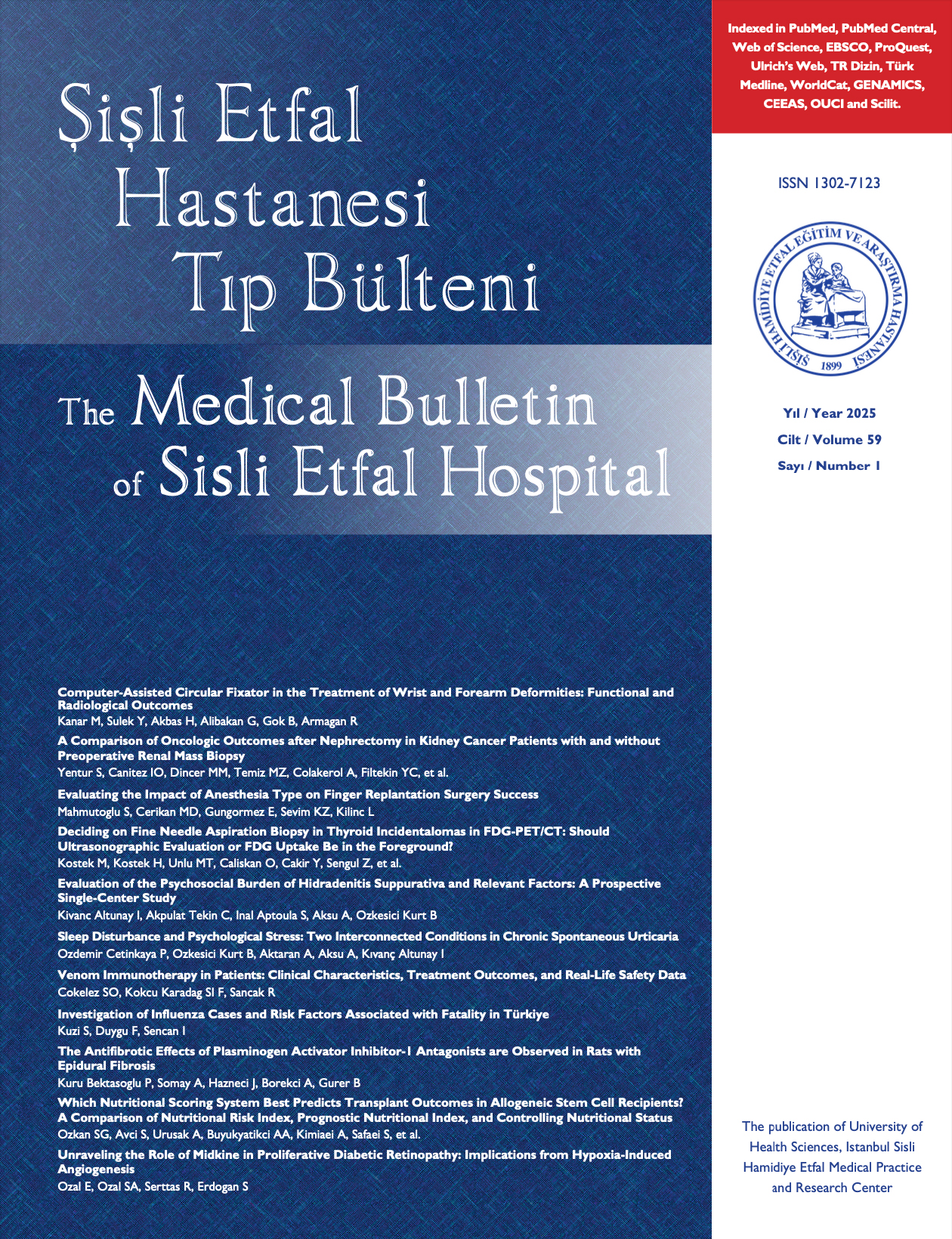
Alt Ekstremite Deformitelerinin Tedavisinde Ilizarov Metodunun Kullanımı
Raffi Armagan1, Metin Kucukkaya2, Haci Mustafa Ozdemir11Türkiye Sağlık Bilimleri Üniversitesi, Şişli Hamidiye Etfal Eğitim ve Araştırma Hastanesi, Ortopedi ve Travmatoloji Kliniği, İstanbul2Florence Nightingale Hastanesi, Ortopedi ve Travmatoloji Kliniği, İstanbul
Amaç: Konjenital veya edinilmiş nedenli alt ekstremite deformitelerinin İlizarov metoduyla tedavisinde komplikasyonlar sıktır. Elde edilecek sonuçlar spesifik hasta gruplarında değişkenlik gösterir. Bu çalışmada etiyoloji türünden bağımsız, deformitesi 16 yaş öncesi gelişenlerle bu yaştan sonra gelişenler elde edilen sonuçlar, tedavi süreleri ve karşılaşılan komplikasyonlar açısından karşılaştırılmıştır.
Gereç ve Yöntem: Aynı cerrah tarafından İlizarov metoduyla tedavi edilmiş ortalama 9,5 (7,5-18) yıl takipli 53 kemik deformitesi, deformitenin oluşum yaşına göre 2 gruba ayrıldı. Demografileri ve deformite özellikleri tanımlanan hastaların tedavi süreleri, kemik iyileşme indeksleri, konsolidasyon/düzeltme oranları, ve elde edilen sonuçlar ASAMİ fonksiyonel ve kemik skorlamasıyla retrospektif olarak karşılaştırıldı. Komplikasyonlar karşılaşılan sorunlar Paleye göre derecelendirilerek guruplar arası göreli risk artışları hesaplandı.
Bulgular: Hastaların 26sı erkek, 22si ise kadındı. Ortalama yaş 26.47 (7-57) idi. Ortalama deformite 23,98° (7-60), 39 hastadaki ortalama kısalık 38,65(10-110)mm idi. Mekanik aks sapması hastaların %83ünde düzeltilebildi. Uzatma indeksi gelişim grubunda 54.13gün/cm, erişkinlerdeyse 63.69 gün/cm idi. Konsolidasyon /düzeltme oranı gelişim grubunda 2.54, erişkinlerde 2.4 (P = 0. 698) dü. Risk ratio, Paleye göre karşılaşılan sorunlar açısından 1.02, engeller için 2, komplikasyonlarda 3, vaka başı toplu karşılaşılan sıkıntılarda 1.34 kat artmıştı. Fiksatörde kalış süresi gelişim grubunda erişkinlerden yüksekti (P: 0.023 ). ASAMİ fonksiyonel (P = 0.000148) ve kemik (P = 0.000242) skorları erişkin grupta daha iyiydi.
Sonuç: Alt ekstremitede konjenital veya edinilmiş deformitelerin İlizarov metoduyla tatminkar sonuçlarla tedavisi mümkündür. Deformitenin küçük yaşlarda gelişmesi tedaviyi güçleştirmektedir. Genelde daha yüksek miktarda kısalık bulunan bu hasta grubunda kemik iyileşme indeksi daha düşük olmasına karşın tedavi genelde erişkin çağı deformitelerininkinden daha uzun; komplikasyonlar daha sık ve ciddidir. Fonksiyonel ve anatomik sonuçlar daha başarısızdır. (SETB-2023-04-070)
The Use of Ilizarov Method at the Lower Extremity Deformity Management
Raffi Armagan1, Metin Kucukkaya2, Haci Mustafa Ozdemir11Department of Orthopedics and Traumatology, University of Health Sciences Türkiye, Sisli Hamidiye Etfal Training and Research Hospital, Istanbul, Türkiye2Department of Orthopedics and Traumatology, Florence Nightingale Hospital, Istanbul, Türkiye
Objectives: Complications are common in the treatment of lower extremity congenital or acquired deformities by Ilizarov method. The results to be obtained vary in specific patient groups. In this study, deformities who developed before the age of 16 were compared with those developed after this age regardless of the type of aetiology, in terms of results obtained, treatment durations and complications encountered.
Methods: 53 bone deformities with an average of 9.5 (7.5-18) years of follow-up treated by the same surgeon were divided into 2 groups according to the age of deformity onset. Demographics and deformity characteristics of patients were defined, treatment times, bone healing indexes, consolidation/correction rates, problems encountered and results obtained were compared retrospectively. The results were compared with ASAMI functional and bone scoring. Complications were rated according to Paley and relative risk increases between groups were calculated.
Results: 26 of the patients were men and 22 were women. The average age was 26.47 (7-57). The mean deformity was 23.98° (7-60) and the mean shortness in 39 patients was 38.65 (10-110)mm. Mechanical axis deviation was corrected in 83% of patients. The Lengthening index was 54.13days/cm in the development group and 63.69 days/cm in adults. Consolidation/correction rate was 2.54 in developmental age and 2.4 (p=0.698) in adults. The risk increased by 1.02 times in terms of problems encountered, 2 for obstacles, 3 times in complications and 1.34 times in total difficulties per case, according to Paley. The duration of stay in the fixator was higher in developmental group (p=0.023). ASAMİ functional (p=0.000148) and anatomical (p=0.000242) scores were better in the adult group.
Conclusion: Congenital or acquired deformities in the lower extremity can be treated with satisfactory results by Ilizarov method. The development of deformity at an early age makes treatment difficult. Although the bone healing index is lower in this group of patients, which usually has a higher amount of shortness, the treatment is usually longer than that of adult deformities; complications are more frequent and serious. Functional and anatomical results are more unsuccessful.
Makale Dili: İngilizce



















